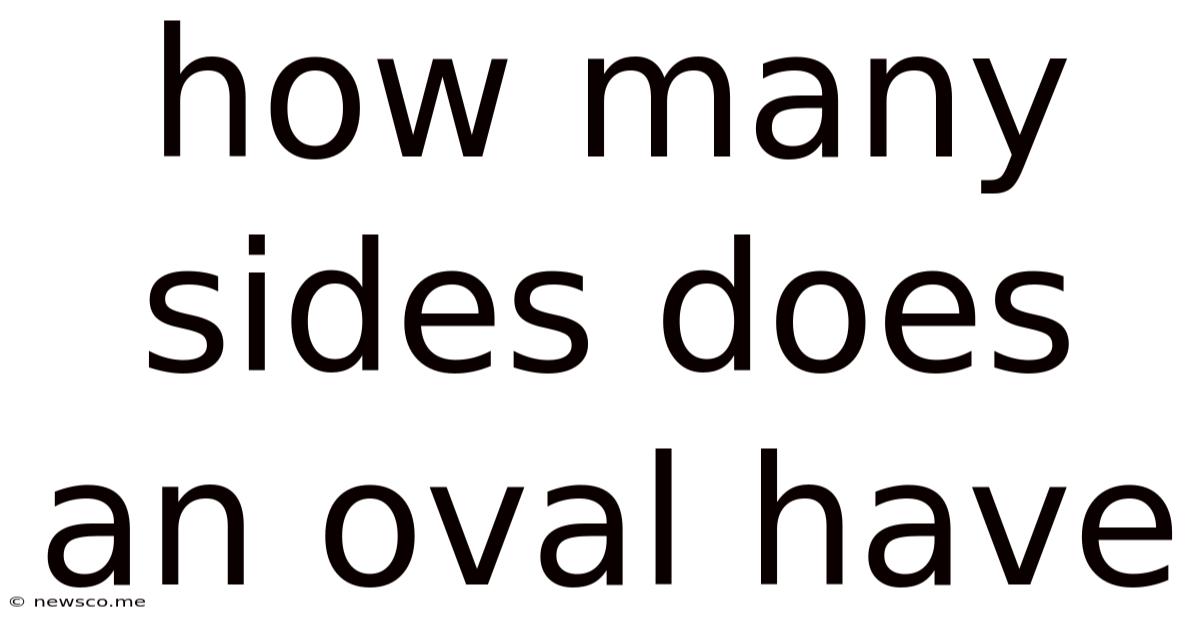How Many Sides Does An Oval Have
News Co
Apr 19, 2025 · 5 min read

Table of Contents
How Many Sides Does an Oval Have? Exploring the Geometry of Curves
The question, "How many sides does an oval have?" might seem deceptively simple. A quick glance might lead one to answer "zero," "one," or even "two." However, the true answer delves deeper into the fascinating world of geometry, specifically the distinction between polygons and curves. Understanding this distinction is key to truly grasping the nature of an oval and its properties.
Understanding Geometric Shapes: Polygons vs. Curves
Before we tackle the oval, let's establish a fundamental understanding of two key categories of shapes: polygons and curves.
Polygons: Defined by Straight Lines
Polygons are two-dimensional closed shapes defined entirely by straight line segments. They possess a specific number of sides and angles, with the number of sides directly corresponding to the number of angles. Common examples include:
- Triangles: Three sides and three angles.
- Squares: Four sides and four angles.
- Pentagons: Five sides and five angles.
- Hexagons: Six sides and six angles.
The defining characteristic of a polygon is its straight edges. This is crucial for determining the number of sides.
Curves: Defined by Continuous Lines
In contrast to polygons, curves are defined by continuous, non-straight lines. They lack sharp angles and their shape can vary greatly. Examples of curves include:
- Circles: A perfectly symmetrical curve where all points are equidistant from a central point.
- Ellipses (Ovals): A closed curve where the sum of the distances from two fixed points (foci) to any point on the curve is constant.
- Parabolas: U-shaped curves defined by a specific mathematical equation.
- Hyperbolas: Curves with two separate branches, also defined by a mathematical equation.
The Oval: A Closed Curve with No Sides
Now, let's return to the central question: how many sides does an oval have? Because an oval is an ellipse, a type of curve, it doesn't have any sides in the traditional sense. The term "side" refers to a straight line segment forming part of a polygon. An oval, being a curve, is comprised of a continuous, smoothly flowing line without any sharp corners or straight edges.
Therefore, the answer is zero. An oval has zero sides.
Exploring the Properties of Ovals (Ellipses)
While an oval lacks sides in the polygonal sense, it possesses other interesting geometric properties:
Foci and Major/Minor Axes
Every ellipse (oval) has two foci, points within the oval. The sum of the distances from any point on the oval to these two foci is constant. The major axis is the longest diameter of the oval, passing through both foci, while the minor axis is the shortest diameter, perpendicular to the major axis.
Understanding these properties is crucial in various applications, from planetary orbits to the design of architectural structures.
Eccentricity: Measuring Oval Shape
The eccentricity of an ellipse is a measure of how elongated or stretched it is. A circle has an eccentricity of 0 (perfectly round), while a more elongated oval has an eccentricity closer to 1. The eccentricity provides a quantitative description of the oval's shape.
Area and Circumference Calculations
Calculating the area and circumference of an oval is slightly more complex than for polygons due to its curved nature. The formulas involve the lengths of the major and minor axes:
- Area: π * a * b (where 'a' and 'b' are half the lengths of the major and minor axes, respectively)
- Circumference: Approximations exist, as there isn't a simple, exact formula. One common approximation is: π * (3(a+b) - √((3a+b)(a+3b)))
These formulas highlight the differences in calculation between polygons and curves. Polygons utilize simpler, straightforward formulas based on the number of sides and angles, whereas curves require more sophisticated mathematical techniques.
Ovals in Art, Nature, and Engineering
The oval shape, though seemingly simple, appears frequently in various contexts:
Art and Design
Ovals are prevalent in art and design, providing a visually appealing alternative to circles and squares. Their smooth, flowing lines create a sense of elegance and harmony. From ancient mosaics to modern logos, the oval shape finds its place consistently.
Nature's Embrace
Ovals appear naturally in many contexts. The orbits of planets around stars are often elliptical, as are the shapes of certain types of cells and some geological formations.
Engineering and Technology
The properties of ovals are exploited in engineering designs. The elliptical shape is used in certain types of gears and machine parts to achieve specific mechanical advantages.
Debunking Common Misconceptions
The seemingly simple question about the number of sides an oval has often leads to confusion and misconceptions.
Misconception 1: An oval has two sides.
This misconception arises from visually perceiving two curves or halves of the oval. However, these curves are continuous and not separate, distinct sides.
Misconception 2: An oval has one side.
This approach considers the entire curve as a single, continuous unit. While not incorrect in a broader sense, it doesn't align with the traditional geometric definition of "side."
Conclusion: Redefining "Side" in the Context of Curves
The question of how many sides an oval has challenges us to refine our understanding of geometric terminology. While the term "side" is clearly defined for polygons, its application to curves requires a more nuanced approach. An oval, being a curve, simply does not possess sides in the traditional geometric definition. Understanding this distinction is crucial for precise communication in mathematical and scientific contexts. The oval, despite its lack of "sides," presents a rich tapestry of geometric properties and finds numerous applications across various fields.
Latest Posts
Related Post
Thank you for visiting our website which covers about How Many Sides Does An Oval Have . We hope the information provided has been useful to you. Feel free to contact us if you have any questions or need further assistance. See you next time and don't miss to bookmark.